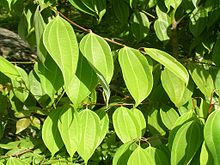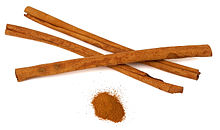 |
|
|
|
|
| Cuisines | Herbal | Spice | Curry | Yeast | Recipe | ||||||
|
Cinnamon Cinnamon is a spice obtained from the inner bark of several trees from the genus Cinnamomum that is used in both sweet and savoury foods. While native only to the island of Sri Lanka, cinnamon trees are now naturalized in South East Asia. Flavour, aroma and tasteIts flavour is due to an aromatic essential oil that makes up 0.5% to 1% of its composition. This essential oil is prepared by roughly pounding the bark, macerating it in seawater, and then quickly distilling the whole. It is of a golden-yellow colour, with the characteristic odour of cinnamon and a very hot aromatic taste. The pungent taste and scent come from cinnamic aldehyde or cinnamaldehyde (about 90 % of the essential oil from the bark) and, by reaction with of oxygen as it ages, it darkens in colour and forms resinous compounds. Other chemical components of the essential oil include ethyl cinnamate, eugenol (found mostly in the leaves), beta-caryophyllene, linalool, and methyl chavicol. Uses Cinnamon bark is widely used as a spice. It is principally employed in cookery as a condiment and flavouring material. It is used in the preparation of chocolate, especially in Mexico, which is the main importer of true cinnamon. It is also used in many dessert recipes, such as apple pie, doughnuts, and cinnamon buns as well as spicy candies, tea, hot cocoa, and liqueurs. True cinnamon, rather than cassia, is more suitable for use in sweet dishes. In the Middle East, it is often used in savoury dishes of chicken and lamb. In the United States, cinnamon and sugar are often used to flavour cereals, bread-based dishes, and fruits, especially apples; a cinnamon-sugar mixture is even sold separately for such purposes. Cinnamon can also be used in pickling. Cinnamon bark is one of the few spices that can be consumed directly. Cinnamon powder has long been an important spice in Persian cuisine, used in a variety of thick soups, drinks, and sweets. It is often mixed with rosewater or other spices to make a cinnamon-based curry powder for stews or just sprinkled on sweet treats (most notably Shole-zard, Persian شله زرد). It is also used in sambar powder or BisiBelebath powder in Karnataka, which gives it a rich aroma and tastes unique. It is also used in Turkish cuisine for both sweet and savoury dishes. Cinnamon has been proposed for use as an insect repellent, although it remains untested. Cinnamon leaf oil has been found to be very effective in killing mosquito larvae. Of the compounds found in the essential oil from cinnamon leaves, cinnamyl acetate, eugenol, and anethole, and in particular cinnamaldehyde, were found to have the highest effectiveness against mosquito larvae. Medicinal valueIn a 2000 study published in The Indian Journal of Medical Research, it was shown that of the 69 plant species screened, 16 were effective against HIV-1 and 4 were against both HIV-1 and HIV-2. The most effective extracts against HIV-1 and HIV-2 were respectively Cinnamomum cassia (bark) and Cardiospermum helicacabum (shoot + fruit). The compound eugenol, a major component of the essential oil from the leaves of the cinnamon tree, has antiviral properties in vitro, specifically against both the HSV-1 and HSV-2 (Oral and Genital Herpes) viruses according to a study published in the journal, Phytotherapy Research. A 2003 study at National Institutes of Health shows benefits of cinnamon in diet of type 2 diabetics. "Cinnamon improves glucose and lipids of people with type 2 diabetes". A study conducted in 2007 and published in the Journal of Medicinal Chemistry suggests that specific plant terpenoids contained within cinnamon have potent antiviral properties. Pharmacological experiments suggest that the cinnamon-derived dietary factor cinnamic aldehyde (cinnamaldehyde) activates the Nrf2-dependent antioxidant response in human epithelial colon cells and may therefore represent an experimental chemopreventive dietary factor targeting colorectal carcinogenesis. Recent research documents anti-melanoma activity of cinnamic aldehyde observed in cell culture and a mouse model of human melanoma. Cinnamon bark, a component of the traditional Japanese medicine Mao-to, has been shown in a 2008 study published in the Journal of General Virology to have an antiviral therapeutic effect. A 2011 study isolated a substance (CEppt) in the cinnamon plant that inhibits development of Alzheimer's in mice. CEppt, an extract of cinnamon bark, seems to treat a mouse model of Alzheimer's disease. |











